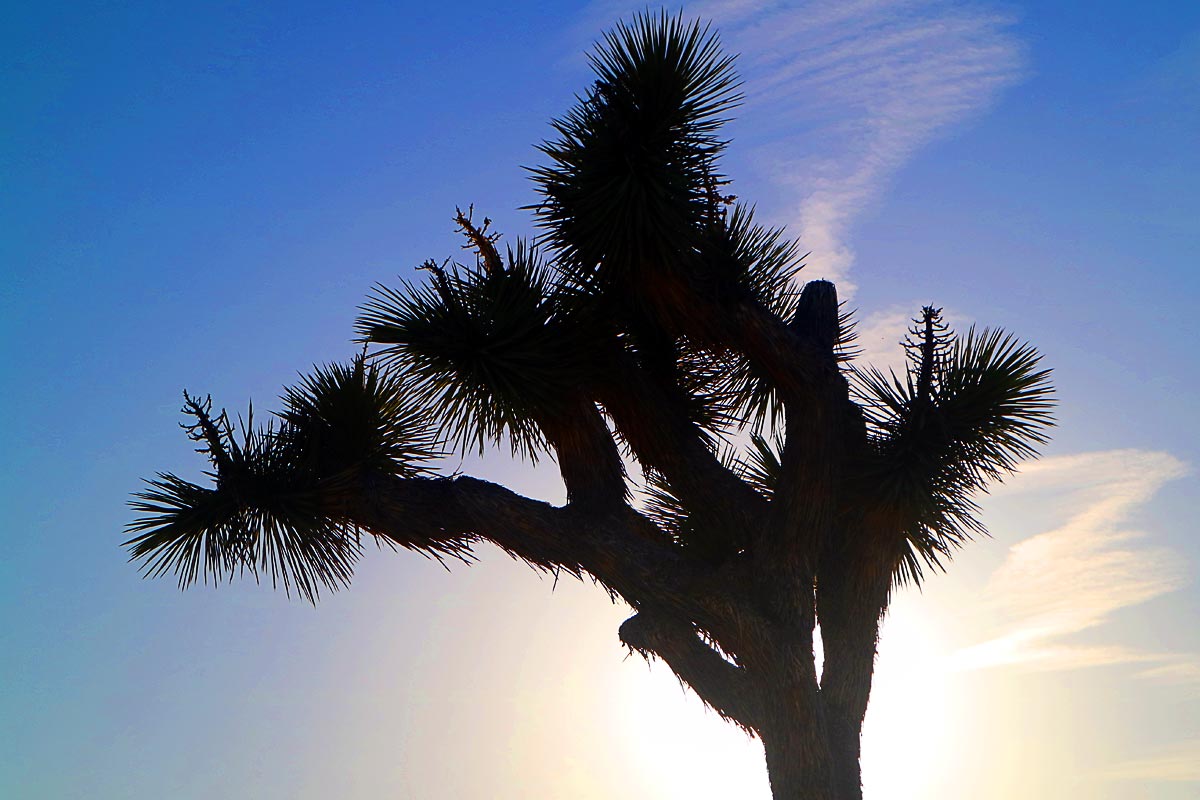
Desert sky
Dream beneath a desert sky
The rivers run but soon run dry
We need new dreams tonight
—U2
It’s impossible to spend too much time in Joshua Tree National Park, and it’s impossible to go anywhere in it and not be confronted with scenes of indescribable grandeur and a kind of austere quirkiness.
Having driven from a clear mountain lake and patches of snow through the desert down to Joshua Tree National Park, we arrived at the park itself late in the afternoon on Day 5 and entered for free (the gate is unstaffed after 5:00 pm). Even before we got to the Park, and certainly once we were inside, Joshua trees were everywhere on both sides of the road.

Craggy limbs reach to the sky with random, comical angularity, all stiff-looking trunks topped with tufts of green pine-like needles. Thousands of trees stretched on both sides to the gigantic rocky hills and piles of boulders in the distance, as the sun was getting lower and lower, the sky and the trees more and more orange, and the equally angular shadows longer and more grotesque.
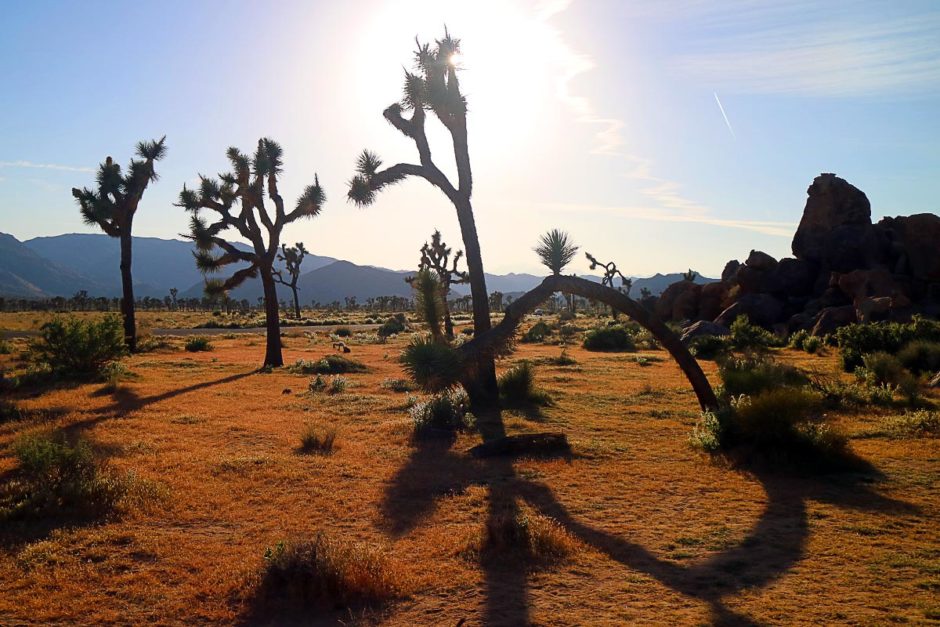
We were on the way to a place called Keys View, a spot at the end of a long lonesome road about one mile above sea level that boasts some of the most sweeping and dramatic views in the entire park. The goal: to catch the sunset.
But, despite our frantic race against the unstoppable rotation of the Earth, we couldn’t help but pull the car over several times to jump out with our cameras, to wander among the trees and regard the smooth, round stones piled several stories high behind them.

Top of Keys View.

The U2 connection
In the minds of many, especially those of a certain age cough cough cough, hearing “Joshua Tree” recalls U2’s legendary 1987 album of the same name. Well, this isn’t lost on the National Park Service, who has a display in their West Entrance visitor center concerning the park and music history. As well as Eric Burdon and Gram Parsons, U2’s album gets a prominent mention and the back cover of the vinyl album sits in a glass case, with a quote from guitarist The Edge featured in the display.
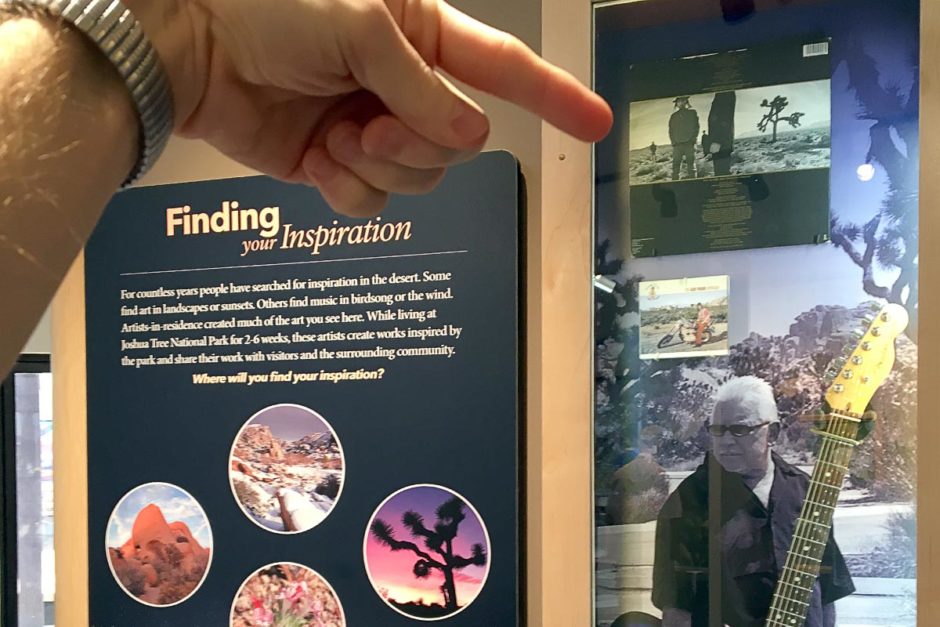
Later, while on top of Keys View, i overheard a girl saying, “Oh my god, Joshua Tree, we listened to that album constantly while driving here!” I bet a lot of people do that. I wanted to myself but had forgotten to put it on my iPhone, whence comes music in the car. And it was nice to drive around with no music in the park anyway.
But next time I get the chance – bullet the blue sky!
We finally arrived at Keys View, where several people were already waiting and the sun was about twenty minutes away from the mountain. That was enough time to gaze down at the heart-stopping view below: rocky hills faded into a distant, red/greyish haze, and far-off mountain ranges had morphed into merely flat shapes with jagged shapes, stacked in succession and each boasting their own individual shade of orange.

Keys View. You can just make out huge Salton Sea in the upper left.

Anticipation among the group ramped up as temperatures plummeted when the sun neared the top of the highest mountains. Soon the perfect orange circle touched the darker earth, a bond between the human world and the celestial forged, and continued to sink down behind the mountain ridges.
It happened quickly; within a few minutes the sun was gone altogether leaving a vast sky full of narrow faded orange-yellows and those same misty stacked shapes of rocky hills. Just as soon as it was over, attention shifted to the opposite side of the sky, where a full white moon was rising in a dark blue sky – this time mountains and Joshua trees were silhouettes.

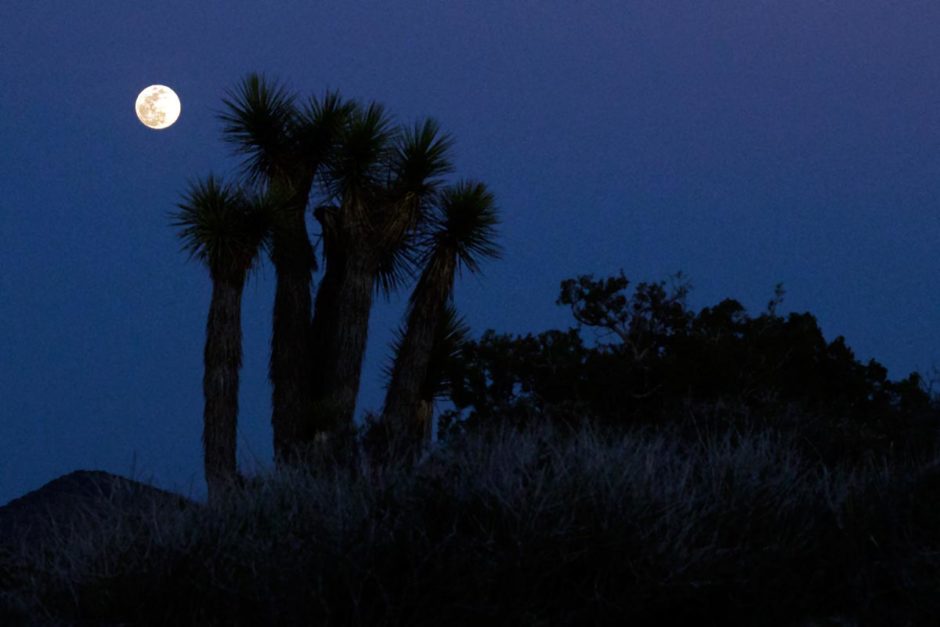
The world’s greatest sunset and an awe-inspiring full moon within five minutes of each other. It was quite a moving experience. What timing – Masayo and I were grateful that we’d spent so much extra time at Big Bear Lake and the San Bernardino Mountains, against our plans.
If people come to Joshua Tree for their own personal spiritual reasons, this was an instructive evening as to why that is.
Our first camping experience (almost)
We bought camping equipment for this trip but hadn’t used it yet; Joshua Tree, our second park after Channel Islands NP, was our chance to break it in. There are several first-come, first-served campgrounds in Joshua Tree and we planned on checking out one of those.
But it was not to be: a sign at the visitor center said that all campgrounds were full. But they offered a backup: the Bureau of Land Management (BLM) had some property a few miles away that they offered for free use for overflow campers.

We drove to it, through the quiet dark of the desert, and found a vast, unlit, unsigned field full of pale green bushes and dusty washboard paths winding through them. We drove through at random, eyes wide through the windshield, trying to find this one specific patch that the map indicated. “Where the streets have no name” indeed.
Finally I pulled off the main “road” and found a little empty patch to park in. We got out of the car and I got the tent out of the trunk. It would be my first time ever setting it up.
Just then a bright light, about 30 yards away, flashed towards us. Other campers? I paused and stared. The light blinked slowly. Was someone trying to signal something? I don’t know any campers’ semaphore codes.
Finally a whiny voice called out. “All this space and yer gonna come up on us?” I walked towards it through the dark, snagging my pants on briars. “You want more space?” I asked. “Yes,” the whiny voice answered. “Where is ok?” I enquired. “Anywhere, clear to the mountain.”
Mountain? What mountain? All I could see was darkness.
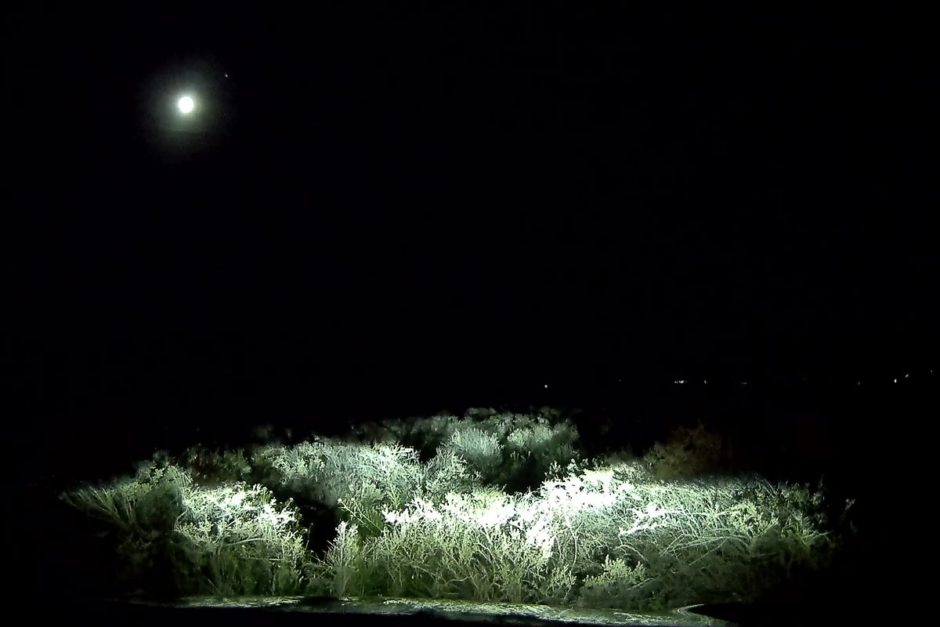
Full moon and Bureau of Land Management bushes. I’m to camp here??
We got back in the car, drove further into the unknown, and pulled off again: half a mile down this path lay another car in my headlights. Well this wouldn’t do either, then.
I put the car in reverse, turned around to see out the rear window, and as I did the sky lit up and I looked over towards the Park – something was streaking across the sky. Bright white fireworks, I guessed.
By this time it was about 8:30 pm and we were getting mighty uninterested in camping. Back in the town of Joshua Tree we pulled up to a motel but a sign on the door said NO VACANCY. Our hearts sank.
So I tried booking.com, and found a Super 8 a few miles away in the town of Yucca Valley who had a room. We booked it, drove there, checked in, and had our campground food in the microwave instead. Soup, triscuits, and a beer in a Super 8. There’s no better meal.
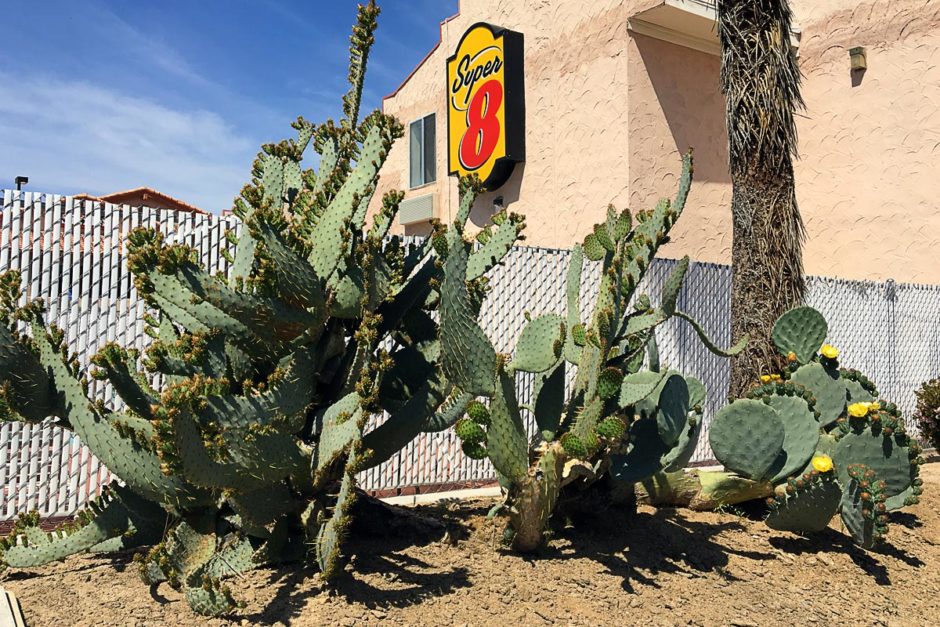
Even better was while watching the local news there was a report on a shooting star lighting up the skies of southern California, including some cell phone video from some lucky person who happened to be taking a selfie video in front of it. It was the “fireworks” I’d seen while lost in the BLM field of shrubs. A tennis ball-sized meteor that managed to light up the sky in a huge swath of a huge state – and I saw it in the darkness of the desert over Joshua Tree National Park.
What a great trip, even if we didn’t get to set up a camp yet!
Joshua Tree NP: Take 2
The next day was Day 6 and we returned to Joshua Tree NP. This time we bypassed the West Entrance from yesterday and went to the North Entrance; we wanted to see other parts of the park. After a brief hike around the Oasis of Mara we entered the park proper and found that, oddly, there were almost no actual Joshua trees in this part. It’s rocky and rolly and there is vegetation, but absent are the eponymous trees.

Cholla Cactus Garden
Diabetics are used to needles, but even I as a Type 1 diabetic since age nine wasn’t ready for the unnerving feeling of walking amongst the endless desert cacti of the Cholla Cactus Garden in the center of Joshua Tree NP.
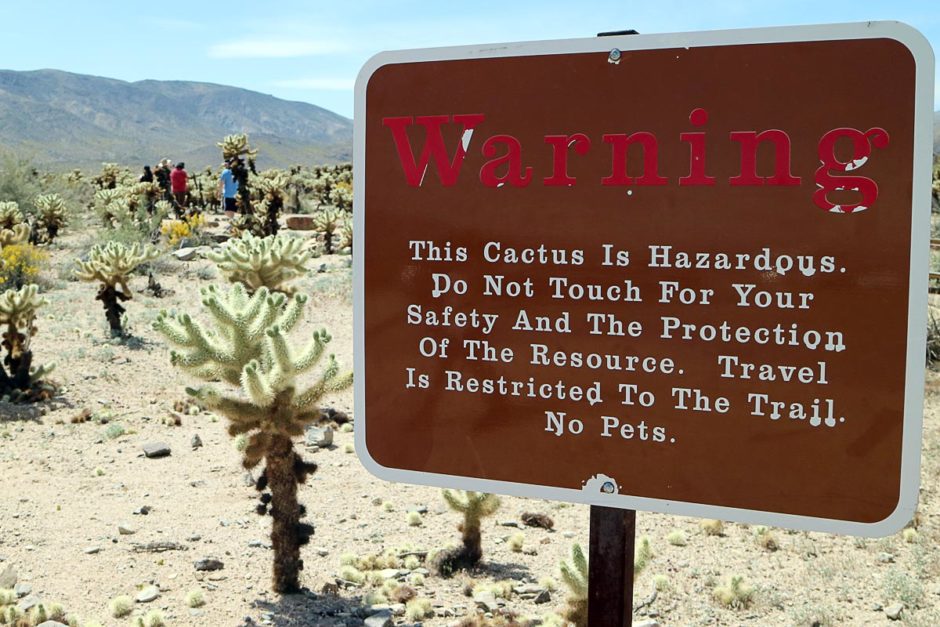
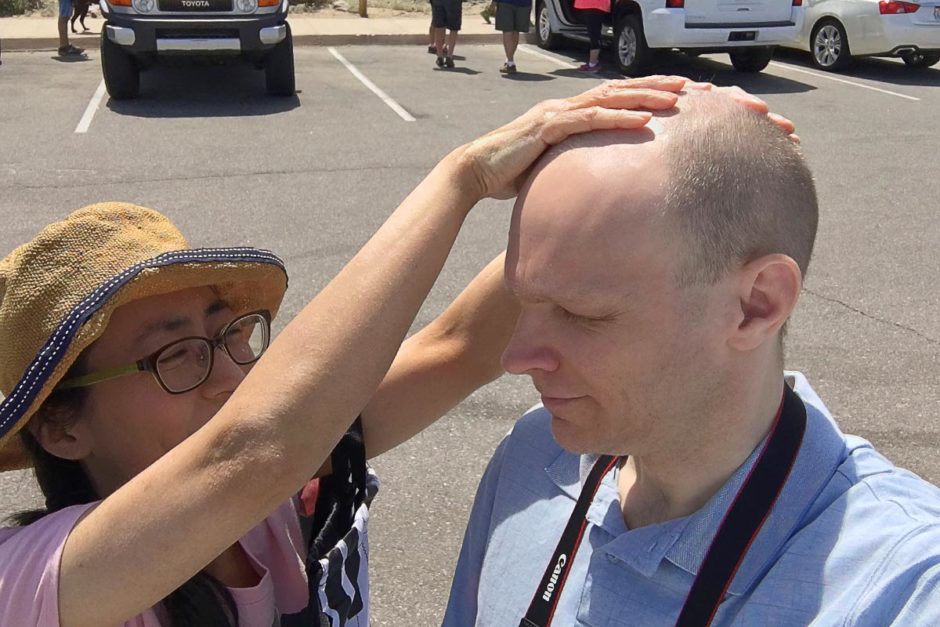
Masayo kindly applies sunscreen to my big round head before entering the cactus garden.
The stop consists of a short walk on a sandy path around hundreds of cactus plants, stalks that look soft and puffy from afar but whose pale green-yellow needles resolve into fearsome bringers of pain and hassle up close. Most are waist-high or so but some reach over your head.

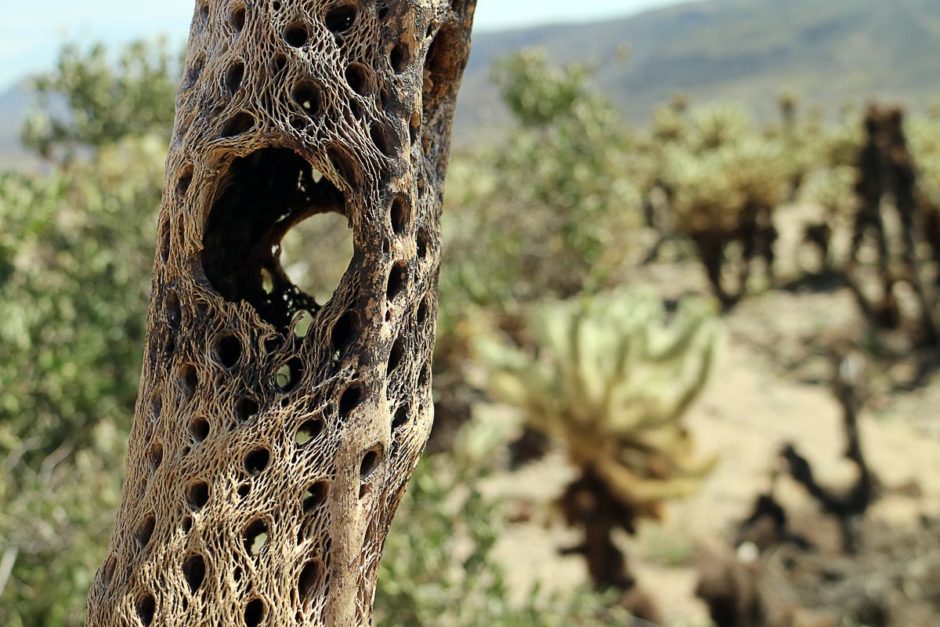
Cactus skeleton.
Several people were there, couples and families on a short walk in the hot sun (even in early April) and being careful not to touch anything, even as a joke or out of curiosity. I know I wanted to, and I know I managed to stop myself. Just.

Whither the turtles?
A sign at the entrance today, which wasn’t there yesterday, warned drivers to be on the lookout for turtles in the roads, wandering around looking for water. (Seeing day-to-day differences like these is a big reason that taking the time and spending more than a cursory few hours in a National Park is a great idea to get a better understanding of the place.)
So we entertained high hopes of spotting a turtle, but as we passed out of the Park boundaries we hadn’t seen one, and had to sigh in resignation. No turtle for us today.


The road out of the South Entrance is a long straight downward slope towards I-10, and ours was the only car in sight. Ahead in the road I saw a tiny black blob but couldn’t tell what it was.
As we drew nearer the blob’s real shape emerged: yes it was a turtle! Excitedly we pulled over and jumped out, and with no other cars around walked (in a friendly, non-threatening fashion) into the road to take a closer look at the tough old grey turtle, whose shell spanned about one foot and whose face looked determined but strained.
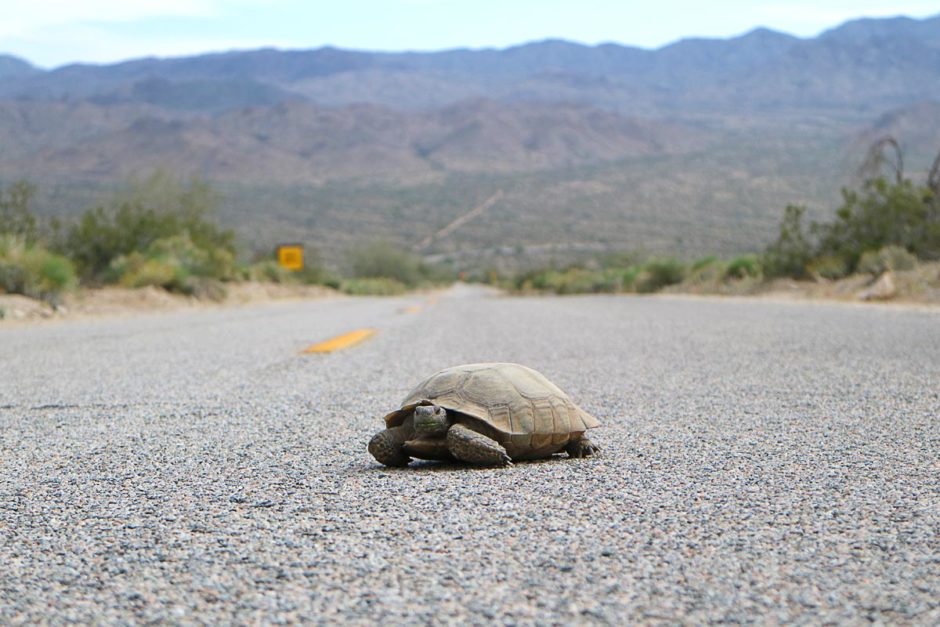
“Hope you enjoyed the Park, folks.”
As we snapped photos and apologized to the turtle for startling it enough that it stopped walking and sat in the center of the highway, other cars arrived and their passengers got out, cooing and taking their own photos and stressing how cute the little guy was. (Or girl, who knows?)
Finally the turtle had had enough of being the center of attention (though between you and me, he seemed to quite enjoy the spotlight for a time) and continued all the way to the far side of the road on his way to whatever a turtle’s destination might be.
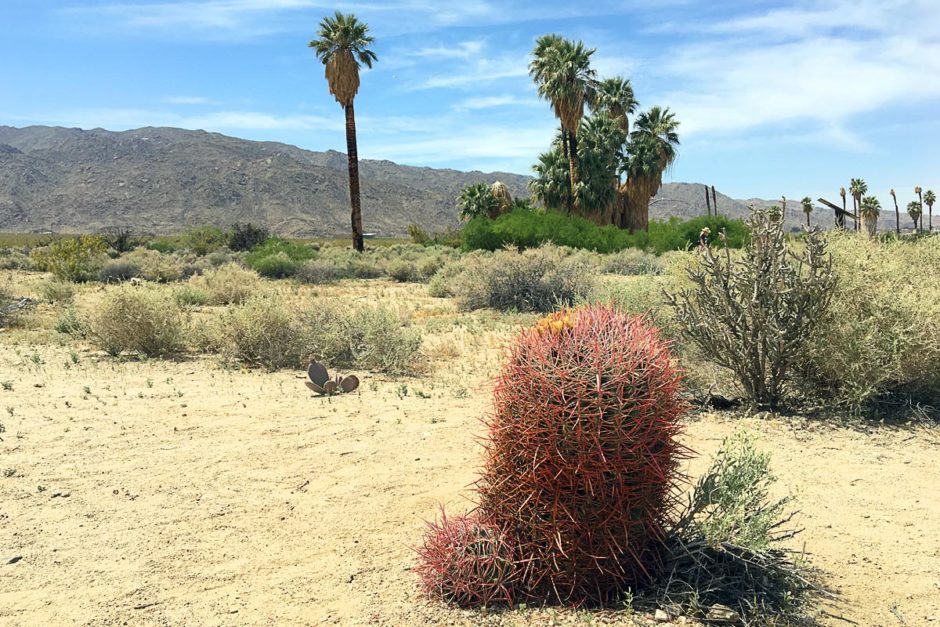
As the others continued to half-encircle the dusty, slow-moving little superstar, Masayo and I climbed back in the car, energized and enthused by our dramatically-timed turtle sighting and the fact that, for a time, it was all for us with nobody else around.
There is no other perfect ending to two perfect days inside Joshua Tree National Park. We were lucky enough to get to know the crazy-looking trees, the sunset over one of the more dramatic views in California, a big beautiful desert moon, towering rock piles, various kinds of cacti, darting kangaroo rats and inquisitive bees… and of course our best friend, the closing number: the turtle.
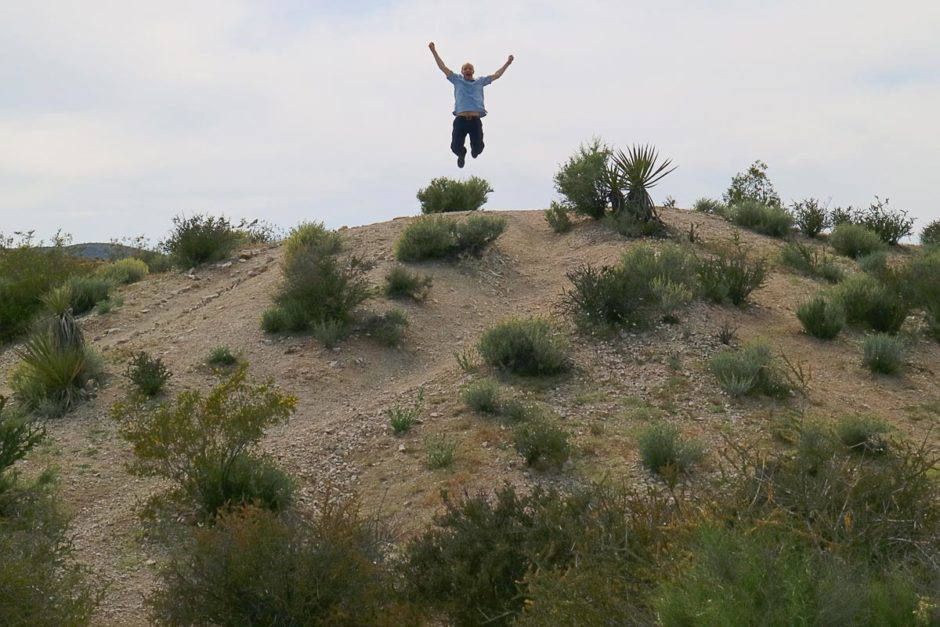
You may not be as lucky as us when you visit Joshua Tree NP, but you cannot help but have a superb time there. There is much to see, and even if you don’t see it all (we certainly didn’t) it’s impossible to go away with anything but big, heady, grand, and yes, even spiritual, memories of a remarkable American region.
Blood sugars blossom into greatness
Day 6 was a big day for me on this trip: my first day with all blood sugars under 200. I use that as a benchmark for how I’m doing. Not a goal, exactly; between 70 and 130 would be better. But if they all start with a “1” or have two digits, I consider that a great achievement.
Today, they were 150, 90, 180, and 85. That’s some masterful T1D care if I do say so myself. And I do.
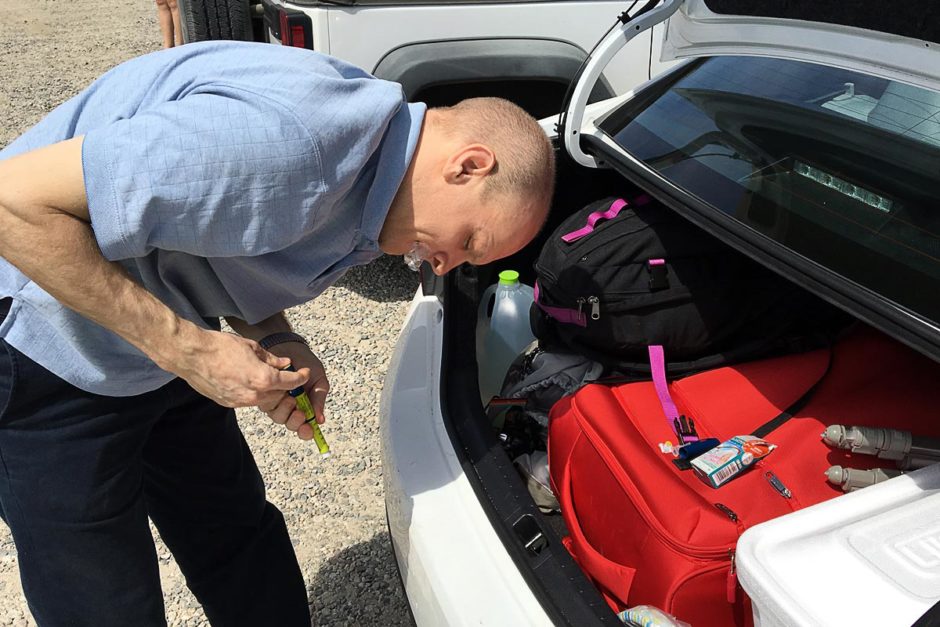
Prepping a new Tresiba pen, parking lot of the West Entrance.
Lunch was particularly excellent; Masayo and I stopped at a covered table area near Cottonwood Spring for sandwiches, applesauce, Chex Mix, and Fig Newtons from the cooler in our trunk. I got out my One Drop meter and checked before eating (this was the 90).
Lunch was good, but since I was running around on nearby hillsides and jumping up and down for the camera I waited until afterwards, sitting in the car in the parking lot again, to take my Humalog for this meal. It worked out; later on in Yuma, Arizona I was 180 before dinner.
Getting smarter about that Chex Mix.
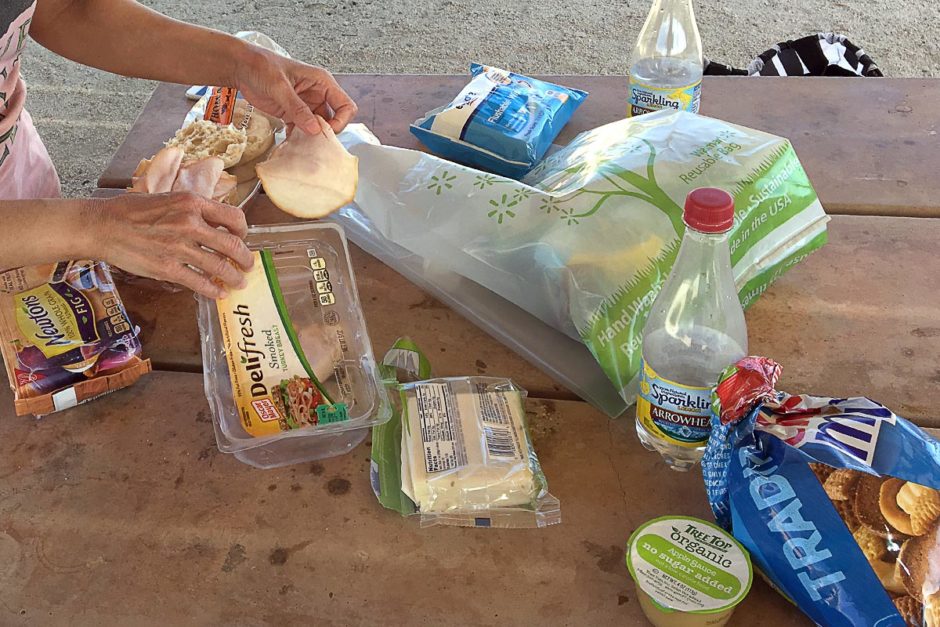
Jet lag, strange sleeping patterns, random road food, and the dry heat of the desert (and whatever else is going on that might affect diabetes) are all behaving. Credit the smoothness of Tresiba, my basal insulin, and some intelligent dosing on my part of Humalog for food. It proves yet again that by paying attention, being aware, and experimenting, you can control diabetes.
I’m sure there will be many more highs over the next three months as I continue this audacious and thrilling (already!) road trip, but I’ve proved that T1D can be controlled even in crazy situations!
Thanks for reading. Suggested:
- Share:
- Read next: Day 8: A lizard beckons us towards ancient desert petroglyphs
- News: Newsletter (posted for free on Patreon every week)
- Support: Patreon (watch extended, ad-free videos and get other perks)

Support independent travel content
You can support my work via Patreon. Get early links to new videos, shout-outs in my videos, and other perks for as little as $1/month.
Your support helps me make more videos and bring you travels from interesting and lesser-known places. Join us! See details, perks, and support tiers at patreon.com/t1dwanderer. Thanks!
